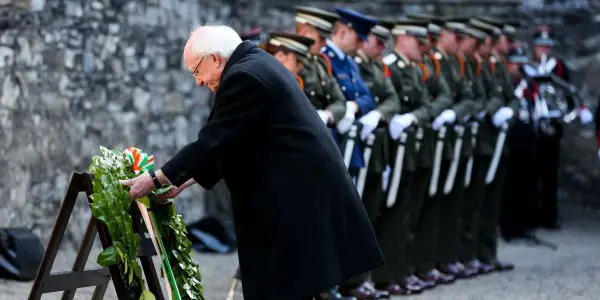Hundreds of thousands of people have lined the streets of the Irish capital for a huge military parade to mark 100 years since the Easter Rising against British rule.
In a centrepiece event as part of a year of commemorations of one of the most defining episodes of Irish history, President Michael D Higgins laid a wreath outside the General Post Office, the former rebel headquarters.
Shortly after midday, he arrived by military cavalcade on O’Connell Street, where the Irish Proclamation was read out by rebel leader Patrick Pearse on Easter Monday 1916.
Acting Taoiseach Enda Kenny invited the head of State to lay a wreath on behalf of the people of Ireland.
“In this centenary year, we honour the memory of those who died in 1916 with the respect and the dignity that is their due and we cherish 100 years later the principles and the ideal contained in our proclamation for which they fought,” he said.
The Easter Rising was a military failure for the revolutionaries, who included poets, journalists and teachers, but it ultimately led to the partition of Ireland and the creation of an independent Republic as well as Northern Ireland.
A minute’s silence was ended by a muffled drumbeat before The Last Post was sounded and the Irish Tricolour, which flew at half mast throughout the wreath-laying, was hoisted to full mast.
As the Army No 1 band played Reveille and the Irish national anthem Amhran na bhFiann, six Aer Corps aircraft flew 700 feet above the capital’s main thoroughfare bellowing smoke in the colours of the national flag.
Despite forecasted rain, the sun shone on the crowds packed into the city centre for most of the spectacle.
After Captain Peter Kelleher re-enacted the reading of the Proclamation spontaneous applause erupted from the onlookers.
Scores of descendants of the rebels looked on.
Former presidents Mary McAleese and Mary Robinson, former taoisigh Bertie Ahern and Brian Cowen, Dublin Lord Mayor Criona Ni Dhalaigh as well as Northern Ireland Deputy First Minister Martin McGuinness, Garda chief Noirin O’Sullivan and British ambassador to Ireland Dominick Chilcott were among the dignitaries.
As part of the ceremony, children representing the four provinces of Ireland – Ulster, Leinster, Connacht and Munster – laid daffodils under the portico of the GPO as a lone piper played Down By The Sally Gardens.
Fr Seamus Madigan, head chaplain of Defence Forces, said the flower-laying was a “symbol of the unshakeable resolve to live together on this island in peace and harmony”.
The event was followed by a military parade along a 4.5km route across Dublin including 3,722 Defence Forces personnel marching in front of military vehicles along with emergency services personnel and army veterans, many of whom served on United Nations’ peacekeeping missions.
A 21 gun salute rang out in the grounds of the Royal Hospital Kilmainham in honour of the revolutionaries.
Earlier, President Higgins laid a wreath at the spot where the rebel leaders were executed for their part in the rising.
In a poignant ceremony at the Stone Breakers’ Yard in Dublin’s Kilmainham Gaol, the President was flanked by a military guard of honour drawn from the Defence Forces cadet school.
After a minute’s silence, a lone piper from the Army No 1 Band played the lament Wrap The Green Flag Around Me Boys, before the Last Post was sounded.
President Higgins used an address to descendants on Saturday to call on Irish people to take responsibility for building a true Republic and said the ideals of the Proclamation can still inspire today.
The commemorations began on Saturday morning when Sabina Higgins, the President’s wife, lays a wreath at the grave of Countess Constance Markievicz in Glasnevin Cemetery.
Following that, the President laid a wreath in the Garden of Remembrance in honour of all those who fought and died for Ireland’s freedom.
On Easter Monday further commemorations are planned at each of the seven key battlefield sites in Dublin.
Wreath laying ceremonies, again open to the public, will take place at the 1916 garrisons including Boland’s Mill, the Jacob’s Factory on Bishop Street, Dublin Castle and City Hall, the Four Courts, the Royal College of Surgeons, Moore Street and at St James’ Hospital, which was the South Dublin Union 100 years ago.
Outside of Dublin simultaneous wreath laying ceremonies will be held in Athenry, Cork, Enniscorthy and Ashbourne.
Also on Easter Monday cultural events are planned in more than 200 venues across Dublin city centre including 500 free talks, exhibitions, debates, film, performances and dramatisations, with six outdoor stages and lots of activities for children and families.
